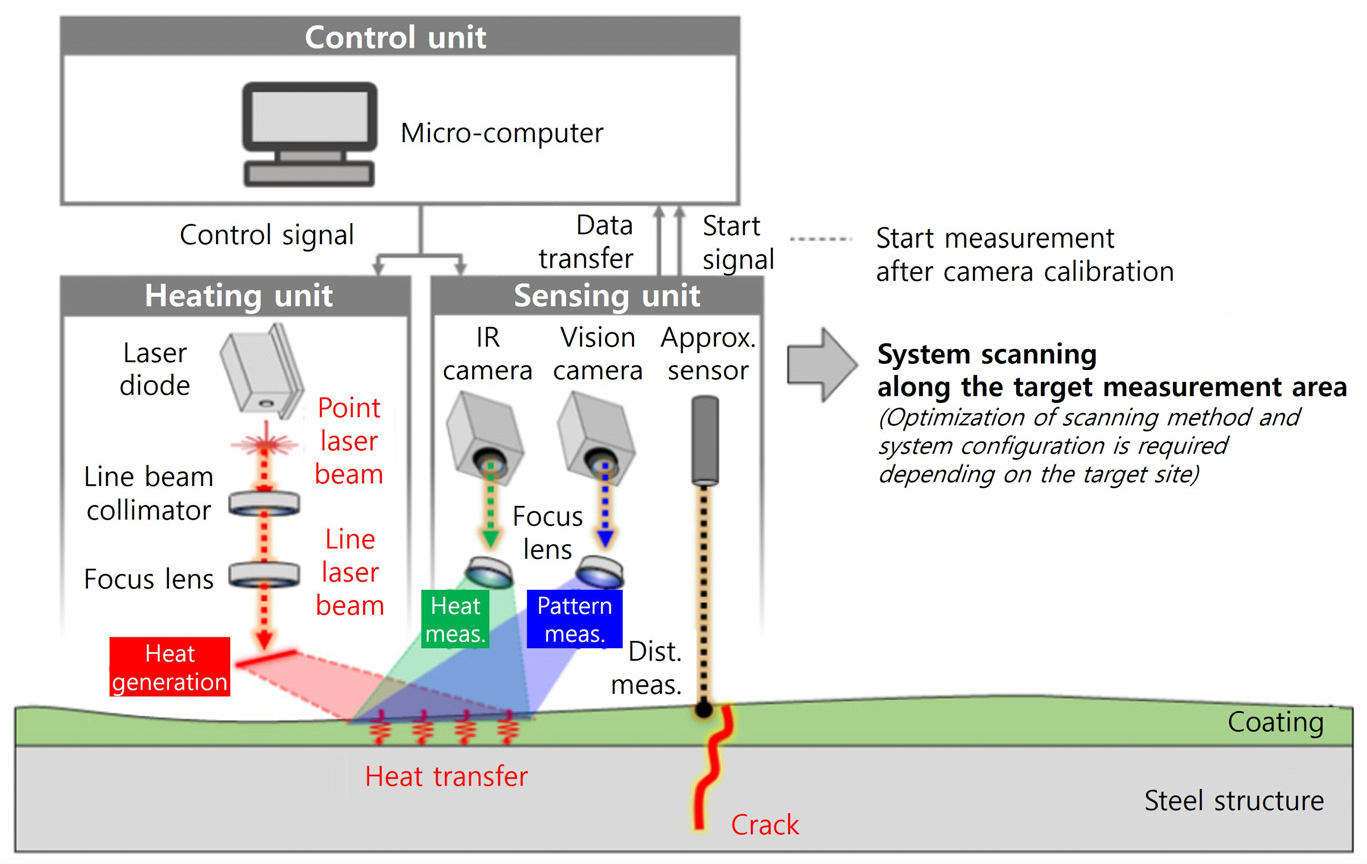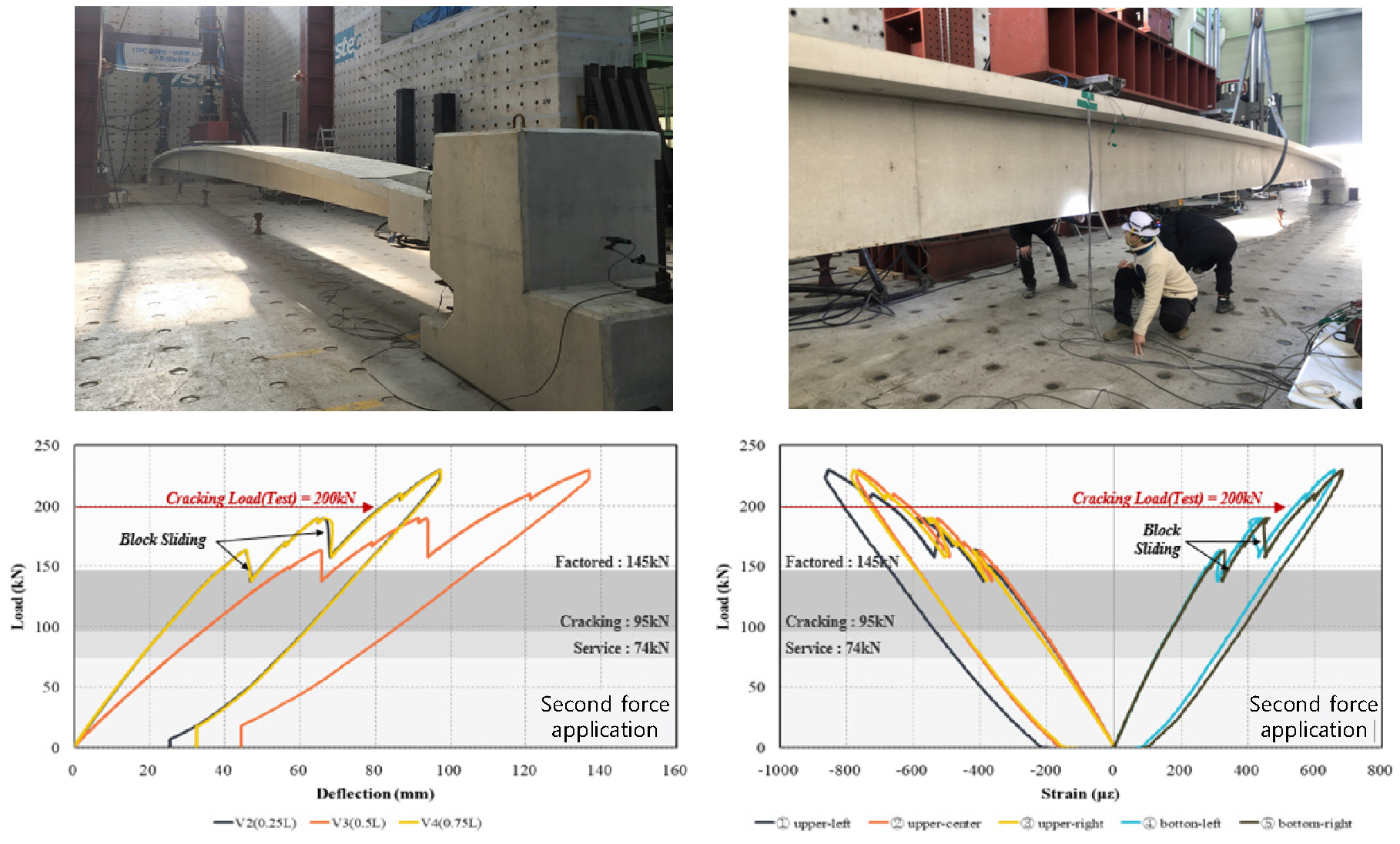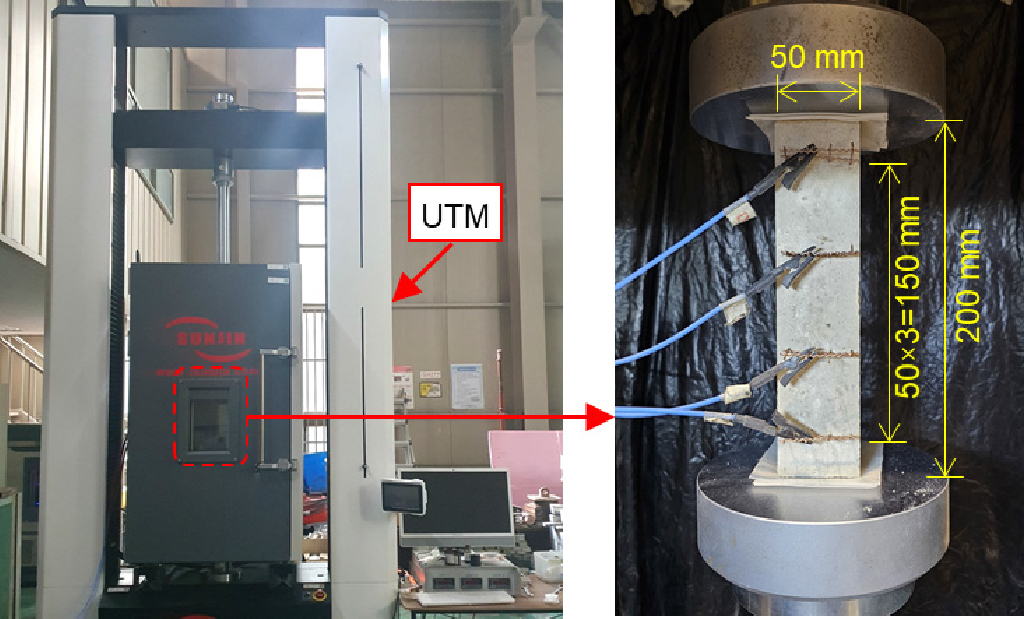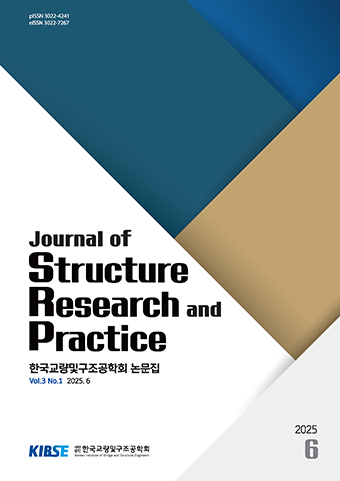-
Research Article

-
Application of Laser Thermography for Detection of Weld Cracks in Steel Structures
강구조물 용접균열 검출을 위한 레이저 열화상 시스템 응용
-
Soonkyu Hwang, Chisung Kim, Hoon Sohn
황순규, 김치성, 손훈
- This study presents a laser-based infrared thermographic technique for detecting weld cracks in steel bridge structures. To enable field application, the system …
본 연구는 강교량 구조물의 용접부 균열을 비접촉 방식으로 탐지하기 위한 레이저 기반 열화상 기법을 제안한다. 레이저 열화상 기법의 현장 적용을 위해 시스템 …
- This study presents a laser-based infrared thermographic technique for detecting weld cracks in steel bridge structures. To enable field application, the system was redesigned to be lightweight and portable by simplifying hardware and data processing components. The system includes a laser excitation unit, an infrared camera, and a control unit, integrated for synchronized operation. Field tests were conducted on U-rib welded joints of an in-service steel box girder bridge. The proposed method visualized fine cracks (30–80 µm) by analyzing abnormal heat propagation patterns and applying phase-locked image processing. To improve detection accuracy, a threshold was determined using a Weibull distribution fit, and image noise was reduced through median filtering. Results confirmed that the system can detect subsurface cracks beneath coating layers in a non-contact and real-time manner. This study demonstrates the feasibility of using active thermography for on-site inspection of welded joints, contributing to automated maintenance of large-scale steel structures.
- COLLAPSE
본 연구는 강교량 구조물의 용접부 균열을 비접촉 방식으로 탐지하기 위한 레이저 기반 열화상 기법을 제안한다. 레이저 열화상 기법의 현장 적용을 위해 시스템 하드웨어를 경량화하고 데이터 처리 절차를 간소화하여 휴대 및 운용성을 강화하였다. 제안된 시스템은 레이저 가진부, 열화상 카메라, 제어부로 구성되며, 동기화된 방식으로 작동한다. 실제 강박스거더교량의 U-rib 용접부를 대상으로 현장 실험을 수행하였으며, 레이저 가진에 따른 표면 열전달 패턴 분석을 통해 균열 폭 30–80 µm 수준의 미세 균열을 시각화하였다. 영상처리 과정에서는 위상잠금 기법과 Weibull 분포 기반 임계값 산정, 중간값 필터링을 적용하여 영상 노이즈를 제거하고 균열 영역을 효과적으로 추출하였다. 실험 결과, 도막층 아래 존재하는 균열을 실시간으로 비접촉 탐지할 수 있음이 확인되었으며, 제안 기술이 현장 용접균열 탐상 기술로 활용될 수 있는 가능성을 제시한다.
-
Application of Laser Thermography for Detection of Weld Cracks in Steel Structures
-
Technical Note

-
Design of the Circular Pylon Cable-Stayed Bridge
원형주탑 사장교의 계획과 설계
-
Chang Sun Lee, Hyun Jae Lee, Jeong Hee Lee, Han Rok Ji, Yeong Jae Jo
이창선, 이현재, 이정희, 지한록, 조영재
- This design introduces the design of the cable-stayed bridge with a circular pylon, planned as the main span bridge of Bridge 3. …
본 설계는 새만금 지역간 연결도로(2공구) 건설공사의 순환링 3교의 주교량인 원형 주탑 사장교의 기본설계 교량계획에 대해 설명합니다. 현장 지반 조사 결과를 바탕으로 주경간이 …
- This design introduces the design of the cable-stayed bridge with a circular pylon, planned as the main span bridge of Bridge 3. in the Section 2 construction of the Saemangeum Regional Connection Road. The main span was expanded to 200 m based on ground survey results. For the symbolic significance and distinctiveness, a circular pylon shape was adopted to represent the Saemangeum circular road. The cable system was designed to ensure the structural stability of the pylon. Bridge 3 is designed as the world’s largest (200 m) cable-stayed bridge with a circular pylon, and it is expected to become an iconic landmark of the Saemangeum region.
- COLLAPSE
본 설계는 새만금 지역간 연결도로(2공구) 건설공사의 순환링 3교의 주교량인 원형 주탑 사장교의 기본설계 교량계획에 대해 설명합니다. 현장 지반 조사 결과를 바탕으로 주경간이 200 m로 적용되었고, 가설여건을 감안하여 PSC 박스거더 상부형식을 적용하였습니다. 원형의 새만금 순환도로를 상징하고 차별화된 디자인을 위해 원형 주탑을 채택하였습니다. 원형 주탑의 구조적 특성을 고려한 단면형상과 케이블을 배치하였습니다. 순환링 3교는 국내 유일 및 세계 최대 종방향 원형주탑 사장교로 새만금 지역의 상징적인 랜드마크가 될 것으로 기대됩니다.
-
Design of the Circular Pylon Cable-Stayed Bridge
-
Technical Note

-
Development and Demonstration of ITPC Tunnel Ventilation Slab System
ITPC 풍도슬래브 시스템 개발 및 실증
-
Do Gyun Kim, Jong Hoon Moon, Ju Hyun Park
김도균, 문종훈, 박주현
- This study introduces the ITPC (Integrated Tunnel & Pre-Cast)-Slab system, a new tunnel ventilation slab structure using mechanical keys instead of traditional …
본 연구는 기존 브라켓 얹힘 방식 대신 결합키를 활용한 수평 연결 방식의 ITPC-Slab 시스템을 제안한다. 이 시스템은 내화 성능 강화, 유지관리성 향상, …
- This study introduces the ITPC (Integrated Tunnel & Pre-Cast)-Slab system, a new tunnel ventilation slab structure using mechanical keys instead of traditional bracket support. The system aims to overcome fire resistance limitations, structural inefficiencies, and maintenance issues in deep urban tunnels. It features a horizontal key-based joint that simplifies installation, minimizes bracket size, and enhances structural integrity. Performance tests confirmed its superior fire resistance, withstanding 2.6 to 2.7 times the design load. Material consumption was significantly reduced—up to 76% in prestressing steel. The design also allows extended slab spans up to 27 m without center supports. Simplified lifting and installation improve maintenance efficiency. It has been applied to the Namhae-Yeosu subsea tunnel project.
- COLLAPSE
본 연구는 기존 브라켓 얹힘 방식 대신 결합키를 활용한 수평 연결 방식의 ITPC-Slab 시스템을 제안한다. 이 시스템은 내화 성능 강화, 유지관리성 향상, 장연장 시공 문제 해결을 목표로 한다. 결합키 구조는 시공을 단순화하고 구조적 안정성을 높이며, 브라켓 및 라이닝 물량을 줄인다. 실물시험 결과 설계 모멘트의 2.6~2.7배에서도 균열이 발생하여 높은 안정성이 입증되었다. 자재 사용량도 최대 76%까지 절감되었고, 27 m 장연장 시공도 가능하다. 남해-여수 해저터널에 최초 적용되었으며, 향후 대심도 지하차도에의 확대 적용이 기대된다.
-
Development and Demonstration of ITPC Tunnel Ventilation Slab System
-
Research Article

-
Effects of Relative Humidity on Electromechanical Properties of Self-Sensing Rapid Repair Material
자가센싱 급속 보수재료의 전기역학적 특성에 대한 상대습도의 영향
-
Tae Uk Kim, Dong Joo Kim
김태욱, 김동주
- In this study, the effect of relative humidity (RH) on the electromechanical properties of self-sensing rapid repair materials (SRMs) was investigated to …
본 연구에서는 자가센싱 급속 보수재료(self-sensing rapid repair materials, SRMs)를 사용한 균열 및 단면 보수 부위의 응력 및 손상 모니터링 기술을 개발하기 위해 …
- In this study, the effect of relative humidity (RH) on the electromechanical properties of self-sensing rapid repair materials (SRMs) was investigated to develop a stress and damage monitoring system for repair area using SRMs. The electromechanical properties of SRMs were investigated at ages of 3, 7, and 24 hours under RH conditions of 40%, 60%, 80%, and 100%. Regardless of age and RH, the electrical resistance of SRMs decreased as the compressive stress increased due to the reduced distance between conductive fine steel slag aggregates (FSSAs) and pores within the matrix. The self-sensing capacity of SRMs improved as the age increased from 3 to 24 hours, attributed to the increase in partially conductive paths resulting from continued hydration. The increase in pore free water at higher RH enhanced ionic conduction and reduced contact resistance, improving the self-sensing capacity by facilitating more continuous conductive paths. However, when RH exceeded 80%, free water formed a stable conductive network that was less responsive to loading, reducing the sensing capability.Under 60% RH at 24 hours, the electrical resistance of SRMs decreased from 4.637 to 4.028 kΩ as the compressive stress increased from 0 to 31.75 MPa, showing the largest reduction of 13.13%.
- COLLAPSE
본 연구에서는 자가센싱 급속 보수재료(self-sensing rapid repair materials, SRMs)를 사용한 균열 및 단면 보수 부위의 응력 및 손상 모니터링 기술을 개발하기 위해 SRMs의 전기역학적 특성에 대한 상대습도의 영향을 조사하였다. SRMs의 전기역학적 특성은 재령 3, 7, 24시간에서 상대습도 40%, 60%, 80%, 100% 조건에서 조사되었다. SRMs의 전기저항은 재령과 상대습도에 관계없이 압축응력이 증가함에 따라 매트릭스 내부에 혼입된 전도성 재료인 제강슬래그 잔골재(fine steel slag aggregates, FSSAs)와 공극들의 사이 거리가 감소함에 따라 감소하였다. SRMs의 자가센싱 능력은 재령이 3시간에서 24시간으로 증가함에 따라 수화반응의 지속으로 인한 부분적인 전도성 경로의 수 증가로 향상되었다. 상대습도의 증가로 인한 매트릭스 내 자유수 함량 증가는 이온전도성을 증가시키고 접촉저항을 감소시켜 자가센싱 능력을 향상시켰으나, 상대습도가 80% 이상으로 증가할 경우 과도한 자유수로 인해 전도성 네트워크가 연속적으로 고정되어 하중에 따른 동적 재구성이 제한되어 자가센싱 민감도가 저하되었다. 상대습도 60% 및 재령 24시간 기준 SRM의 전기저항은 압축응력이 0에서 31.75 MPa로 증가함에 따라 4.637에서 4.028 kΩ으로 13.13% 감소하여 가장 큰 전기저항 감소량을 보였다.
-
Effects of Relative Humidity on Electromechanical Properties of Self-Sensing Rapid Repair Material
Journal Informaiton
 Journal of Structure Research and Practice
Journal of Structure Research and Practice
Journal Informaiton
Journal Informaiton - close
 Journal of Structure Research and Practice
Journal of Structure Research and Practice










